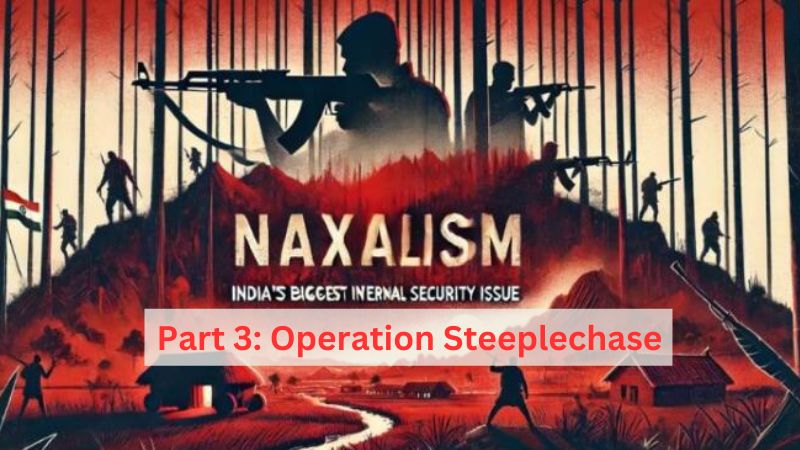By essence, a state and its subjects are two poles which are complementary to each other. Subjects see the state as protector, giver and facilitator but when, deliberately or not, the state falls short to fulfill this duty, resentment forment among the public. The state’s sovereign, coercive power widens the difference between them. And in that situation, when a spark of revolt emerges, people become moderate to it without seeing the larger picture or the pros and cons. Same happened with the rise of Naxalism in India.
In the last part, we traced the emergence of Naxalism from the cadre of communists, who used peasantry as a pawn in the game. For a better understanding, the last part discussed Naxalism till 1970. In this part we are going to discuss the later scenario of how it developed and how the full fledged operation started against them.
After the Naxalbari uprising, the little success of CPI-ML in the region inspired similar movements in other states including Odisha, Maharashtra, Karnataka, Chhattisgarh and other parts of West Bengal and modern day Telangana.
In 1970, in the first CPI-ML Congress, Mazumdar called upon his cadres to “Expand anywhere and everywhere’’.
Also Read: TFI Series on Naxalism Part 1: March 2026 deadline: Security forces launch final strike on Naxalism
Charu Mazumdar, in his Historic Eight Document, laid out the entire mechanism which promoted protracted armed struggle to topple the contemporary set up. Those radicals who were at the receiving end of the repercussions of nascently independent and highly fragile state policy swore allegiance to Naxalism with a mindset that their ‘war’ will be long drawn.
This blurred the sight of their wisdom and they got involved in guerilla war, which they perceived will be upped to mobile war and ultimately positional war which is conventional.
As per the Maoist ideology, they targeted rural and jungle areas as their base because of three reasons— First, the deprived residents living in these areas could be easily manipulated, secondly, it gave them cover against armed forces and thirdly, these areas were most prudent for waging guerilla warfare.
Maoist ideology believed that if the urban areas would get surrounded by areas having their strong hold, crushing the state would become a cake walk.
With changing circumstances, Mazumdar advocated for struggle in cities. At the outset, Naxalism was by, for and of villages but overtime cities became prominent centres of influence and hence, Naxals promoted their ideology within young minds, that is, students. They infiltrated student politics and envisaged that when the state would be cornered by armed Naxals, these students would act as their asset in the insurgency.
By mid 1970, Naxalism was at its peak with around 4,000 incidents in the country, as quoted by Sanjai Singh in his paper ‘Land Reforms and Effect on Naxalism’ and wielded influence in nearly 170 districts.
As said the movement spread in other parts of India and predominantly in Andhra Pradesh and Bihar.
At this point in 1971, Indira Gandhi, the then prime minister, announced ‘Operation Steeplechase’. Undertaken between July and August, the operation made a significant dent on the Naxal movement in India. It was the first major operation by India undertaken jointly by the Police, Army and CRPF.
The operation, which was strategically planned, had Army cordon at the outer ring with CRPF deployed at the inner ring and the police along with magistrates at the centre.
As a result of coordinated attempts, huge numbers of Naxalites were arrested, their den were uncovered, weaponry was confiscated.
In the biggest blow, 1,400 Naxals were arrested in Andhra Pradesh, 2,000 in Bihar, 4,000 in West Bengal and 1,000 in Kerala. By March 1972, all major figures of the movement were behind the bars. On July 16, 1972, the Naxal ideologue Mazumdar was also arrested. Weeks later, he died and the movement headed to its natural death.
After Mazumdar, the CPI-ML fragmented further due to lack of leadership and vision. Mazumdar, though had pitched for the student movement for the rise of Naxalism in urban areas, remained highly ineffective.
Broadly speaking, Steeplechase broke the spine of the armed movement of Naxals. On the other hand, the land reforms and Left front West Bengal government’s aggressive implementation helped many tenants and landless farmers.
Under the ceiling act, Bengal’s left govt declared 1.37 million acres as surplus land for redistribution and reallocated 1.04 million acres to 2.54 million relatively poor households.
The moral motive behind the armed struggle was crushed. The Bengal government also brought operation Barga to regulate landowner and sharecropper relations.
In principle, the context of Naxal movement died with the land reforms, on the resistance front it lost in Operation Steeplechase.
The Naxal movement fell to an all time low within 5 years of its rise. Although it was a big success, Operation Steeplechase, however, didn’t end the menace completely. After the moral background for armed struggle was lost and the organisational set up was fragmented, a new band of Maoists continued their struggle since the late 1970s. Being ideologically unfit in attracting masses, the later movement was more chaotic and anarchic than the previous one. The only difference was that the earlier movement had appeal to the masses and intellectuals while the latter had influence only on those who were deceived.
In the next part, we will discuss the fall of Naxalism after Mazumdar’s death, birth of CPI (Maoist).
